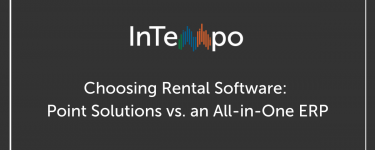Three Signs You’ve Outgrown Your Rental Software
When you first choose software for your rental business, it can be hard to predict which features you’ll need as you grow. Simplicity often wins out – and sometimes, price does too.
However, as you grow your rental fleet – and your customer base – you’ll almost certainly change the way you do business. The processes you follow as a single-location shop will be much different than the ones you will need as a 2, 3, or 4+ location company. Similarly, if you open a dealership to complement your rental operations, acquire smaller rental companies as you grow, or set ambitious growth goals for increasing revenue and profits, you’ll need a software system that can sustain your growth.
The flip side of that: changing rental software is a time-consuming process. Moving to a new system every 2-3 years is costly and inefficient. However, staying on an entry-level system when you’re no longer a start-up can keep you from reaching your fullest potential.
So: how do you know that you’ve outgrown your rental software to the point that changing systems is worth the effort?
1. You’re creating manual workarounds for processes your current system can’t accommodate.
If your rental software doesn’t accommodate the way you do (or want to do!) business, you’ll have to work with what your system can do. For instance, if you can’t automatically accommodate cycle bills, your accounting team will have to manually intervene at the end of each month, when they’re already buried under a mountain of work. If you can’t manage warranties for your dealership on the same software you manage your rental contracts on, you’ll need to maintain two separate systems to get the full run of features. If you want to print out a daily down equipment list and your software can’t export the data you need, you’ll have to come up with a different way to track your open repairs. Or, if you sell an asset out of your rental software, you really won’t know your gain or loss on the sale until you factor in the cost of goods sold (COGS) from your fixed asset software. These are just a handful of examples where disconnected processes end up taking more time and resources than they would in a full-featured rental software system.

A lack of flexibility doesn’t just hurt you in your day-to-day; it makes it so that you can’t make meaningful long-term changes. The longer you’re in the rental business, the better you get to know your customers and your market. When you find yourself coming up with promising new ideas but have no way to put them into action, it’s time to consider more flexible software that won’t get in the way of your growth.
Related: Why You Should be Using Rental-Specific Accounting Software
2. You can’t integrate with your other technologies.
Are you maintaining multiple solutions that don’t communicate with each other? If you manage one system for accounting, one system for operations, one system for maintenance, and so on, you’re spending more time going from application to application than you are getting things done. (Worse: you end up sitting around, waiting for data to be pushed from one application to another before you can even get started on your to-do list.)
Of course, with many rental companies using telematics software, Customer Relationship Management (CRM) solutions, and other third-party technologies, it’s not always possible to use one solution and one solution only. This is especially true if you want to take advantage of the best-in-class features that the most widely used systems have to offer.
That’s where real-time integrations can help. You can use one central system as your primary “hub”, then push data out or pull it in from your other solutions. You don’t have to manually re-enter data in multiple places or consolidate reports from multiple sources; you go to one place and that’s the end of that. And, you don’t have to sacrifice the benefits of the industry-leading systems and further limit yourself to the functionality of one software brand.
3. You’re paying per-user license fees that don’t make sense at scale.
Growing your team is a good thing – but when you’re paying license fees for each new user, it can get expensive. Some try to cheat the system by sharing the same login credentials. This presents its own pitfalls. You now lose track of accountability in the system and have no idea who run a specific transaction or issued a credit. Alternatively, the original user may need to wait for the other user to finish their work so they can log in and do their job which is a huge waste of time.

As you start getting into the world of additional seats, per-user charges, and shared accounts take a moment to consider your total cost of ownership. You may find that your entry-level rental software costs more than you’d originally anticipated – without delivering the value that makes it worth the investment.
Discover the Last Rental Software You’ll Ever Need
Our rental software is designed to support you at every stage of your growth. Whether you’re a two-location A/V shop or a multi-million-dollar heavy equipment operation, we’re here to provide you with easy-to-use, easy-to-scale tools.
InTempo Enterprise delivers an all-in-one platform for accounting, operations, purchasing, maintenance, dispatch, and sales. You get everything you need to manage your day-to-day operations, plus robust reporting and integration capabilities to help you grow. With complete flexibility to support your most critical processes – both now and in the future – it’s the last rental software you’ll ever need.
Ready to see it in action? Contact us today or request a demo here.


